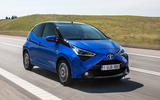What is it?
The second-generation Toyota Aygo has proved to be a successful model for the Japanese manufacturer since it was introduced in 2014. In 2017 alone, no less than 22,264 examples of the distinctively styled Aygo rolled out of UK dealer showrooms. Not only did this account for 12% of the competitive city car market, it made the Aygo the third most popular car in its class.
For 2018, Toyota has treated the Aygo to a mid-cycle refresh in a bid to keep it competitive against the likes of the Volkswagen Up and Skoda Citigo, as well as the Peugeot 108 and Citroën C1 with which it shares its platform. As is often the case with midlife facelifts, the latest Aygo is fairly similar to its predecessor, yet the changes made distinctive enough to help it stand out next to the older model.
From a visual standpoint, the most noticeable tweak can be seen at the front of the car, where the black two-dimensional ‘X’ motif has been turned into a three-dimensional, architectural feature of the car’s nose. There are new light signatures front and rear, and a range of new 15in alloy wheels have been rolled out across the range.
The line-up has also been tweaked, with X specification representing the entry-level offering, followed by X-Play, X-Plore, X-Cite and X-Clusiv. A limited-run X-Press trim is also available, of which 2500 examples will be built. Prices start at £9,695 and rise to £14,595.
Toyota’s 1.0-litre three-cylinder petrol engine remains, although with a number of tweaks to marginally improve performance and efficiency and reduce friction. It now develops a modest 71bhp at 6000rpm — up from 68bhp in the previous model — while outright torque has decreased to 68lb ft from a fairly heady 4400rpm, although there’s more of it in the mid-range.

































Join the debate
Add your comment
The interior centre stack is hideous
Cheap nasty looking plastic and a horrid design
Shame, because the car looks really good on the outside
Not good enough
When the MK1 triplets were launched in '05 they already felt more like toys than " real " cars, and this gen has barely made that better. With most of the competition having improved their offerings by a lot, it's really hard to understand why someone would choose one of these ( or a C1/108 ), other than they maybe got a great deal on one.
I'd take a Picanto or an Ignis.
Spare a thought
Spare a thought for the poor Cyberman grafted on to the dashboard.